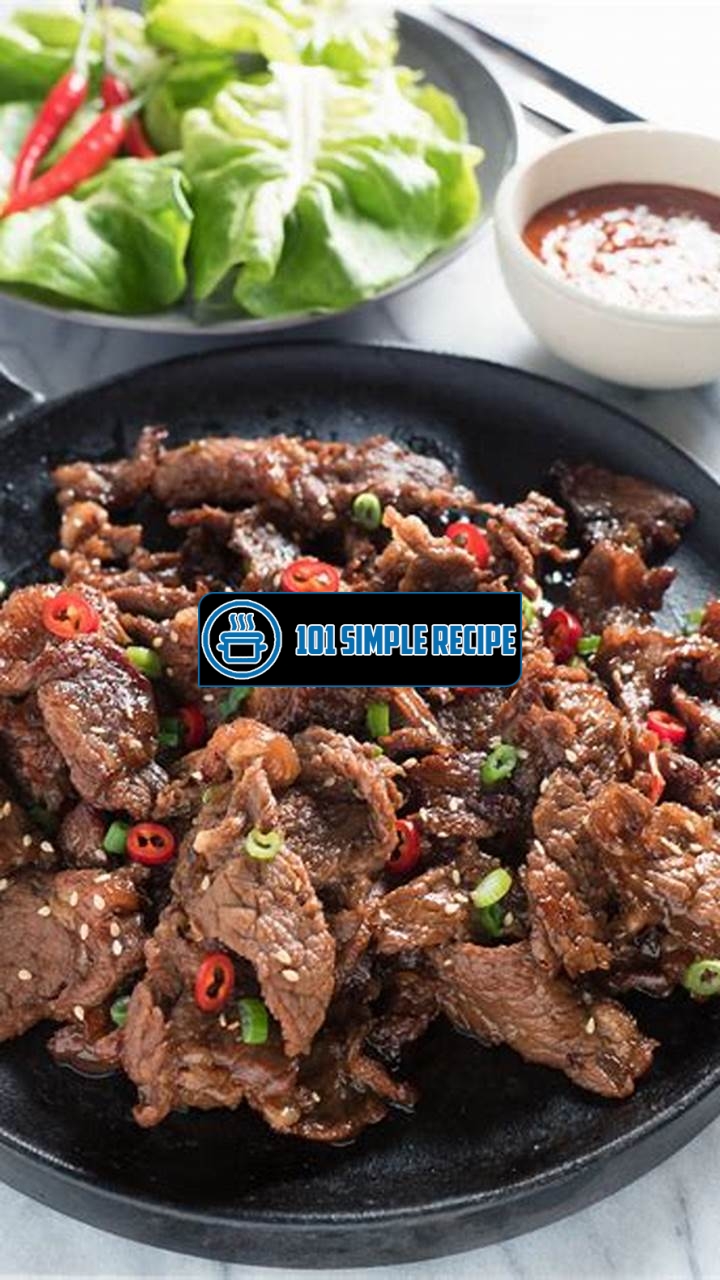Get ready to be transported to the vibrant streets of South Korea as you discover the art of making authentic Bulgogi! Derived from the Korean words “bul” meaning fire and “gogi” meaning meat, Bulgogi is a beloved dish that represents the rich culinary heritage of Korea. This marinated and grilled beef dish is known for its tender texture, tantalizing flavors, and the perfect balance of sweet and savory. So put on your apron, gather your ingredients, and let’s dive into the world of Bulgogi culinary mastery! ✨

Understanding Bulgogi
Discover the origins and key characteristics of bulgogi, a popular Korean dish loved for its flavorful marinade and tender meat.
The History of Bulgogi
Bulgogi is a Korean dish that has been enjoyed by locals and tourists alike for generations. The word “bulgogi” translates to “fire meat” in Korean, which perfectly captures the essence of this flavorful dish. The history of bulgogi can be traced back to the Goguryeo era in the fourth century, where it was originally called “maekjeok.”
During the Goguryeo era, when battles were fought on horseback, warriors needed a convenient way to cook meat quickly. This led to the creation of bulgogi, which involved thinly sliced pieces of marinated meat that were grilled over an open fire. The unique marinade not only added flavor but also helped tenderize the meat, making it easier to chew and digest.
Over the centuries, bulgogi has evolved and adapted to different regional tastes and cooking techniques. Today, it is an integral part of Korean cuisine and a favorite among locals and international food enthusiasts.
Key Ingredients in Marinade
The key to the deliciousness of bulgogi lies in its marinade. The marinade is a combination of various ingredients that work together to create a harmonious blend of flavors. These include:
- Soy Sauce: The base of the marinade, soy sauce adds a savory and umami-rich taste to the meat.
- Sesame Oil: This fragrant oil adds a nutty flavor and a touch of richness to the marinade.
- Garlic and Ginger: These aromatic ingredients add depth and a hint of spiciness to the marinade.
- Asian Pear: Known for its natural tenderizing enzymes, an Asian pear helps to soften the meat and adds a subtle sweetness.
- Brown Sugar: Brown sugar provides a touch of sweetness to balance out the savory flavors of the marinade.
- Sesame Seeds: These tiny seeds add a delightful crunch and a nutty taste to the bulgogi.
- Green Onions: Chopped green onions add freshness and a mild onion flavor to the marinade.
By marinating the meat in this flavorful mixture for at least a few hours, the flavors penetrate the meat, resulting in an incredibly delicious and tender dish.
Cutting and Selecting Meat
The choice of meat and the way it is cut are vital aspects of making authentic bulgogi. Traditionally, bulgogi is made with thinly sliced beef, typically ribeye or sirloin. The thin slices allow the marinade to fully penetrate the meat, resulting in a flavorful and tender final dish.
When selecting the meat, look for well-marbled cuts, as the fat helps to keep the meat juicy and tender during the grilling process. To achieve the perfect thin slices, it is recommended to partially freeze the meat before cutting it. This firmness makes it easier to slice the meat thinly and evenly.
Once the meat is sliced, it is ready to be marinated and grilled to perfection. The combination of the flavorful marinade and the cutting techniques ensures that each bite of the bulgogi is a burst of authentic Korean flavors.
Looking to add some flavor to your bulgogi? Try this teriyaki beef recipe. The sweet and savory sauce will take your bulgogi to the next level.
A Flavorful Marinade
Unlock the secrets to creating a mouthwatering bulgogi marinade that combines sweet, savory, and umami flavors. To master the art of making authentic bulgogi, you need to start with a flavorful marinade that will infuse the meat with deliciousness. The marinade is the key to achieving that tender and juicy texture that makes bulgogi so irresistible.
Traditional Ingredients
In order to create an authentic bulgogi marinade, it’s important to use traditional ingredients that add depth and complexity to the flavor profile. The basic bulgogi marinade typically consists of soy sauce, sesame oil, brown sugar, garlic, ginger, and green onions. These ingredients work together to create a harmonious blend of sweet, savory, and umami flavors.
Tip: To enhance the umami taste, you can add a splash of rice wine or mirin to the marinade. This will give your bulgogi an extra layer of complexity.
Creating the Perfect Balance
The key to creating a mouthwatering bulgogi marinade is achieving the perfect balance of flavors. It’s important to strike a harmonious balance between sweet, savory, and umami. Start by combining the soy sauce, sesame oil, and brown sugar in a bowl. The soy sauce provides a rich savory base, while the sesame oil adds depth and nuttiness. The brown sugar brings a touch of sweetness to balance out the savory flavors.
Tip: Adjust the amount of brown sugar according to your personal preference. If you prefer a sweeter marinade, add a bit more brown sugar. If you prefer a more savory marinade, reduce the amount of sugar.
Next, add minced garlic and ginger to the bowl. These aromatic ingredients add a burst of flavor and complexity to the marinade. Finally, finely chop the green onions and add them to the mixture. The green onions not only add a fresh and vibrant element to the marinade but also provide a subtle onion flavor.
Marinating Techniques
Once you’ve created your bulgogi marinade, it’s time to marinate the meat. The longer you marinate the meat, the more flavor it will absorb. Ideally, you should marinate the meat for at least 2 hours, but overnight marination yields the best results.
Tip: To ensure that the meat is evenly coated with the marinade, you can place it in a ziplock bag and massage the marinade into the meat. This helps the flavors to penetrate the meat evenly and ensures that every bite is bursting with flavor.
Before cooking the marinated meat, make sure to drain off any excess marinade to prevent the meat from becoming overly soggy. You can then grill the meat, either on an outdoor grill or a stovetop grill pan, until it is nicely caramelized and cooked to your desired level of doneness.
Tip: Serve your bulgogi with a side of steamed rice and some fresh lettuce leaves for wrapping. This adds an extra layer of texture and freshness to the dish.
In conclusion, mastering the art of making authentic bulgogi starts with creating a flavorful marinade. By using traditional ingredients, balancing the flavors, and employing proper marinating techniques, you can unlock the secrets to crafting a mouthwatering bulgogi dish that will impress your family and friends.
Choosing the Right Meat
When it comes to making the perfect bulgogi, choosing the right type of meat is crucial. The meat you choose will determine the overall taste and texture of your dish. It’s important to select cuts that are tender and flavorful, as these qualities will greatly enhance your bulgogi experience.
The Role of Beef
Beef is the traditional choice for bulgogi, and for good reason. Its rich flavor and tender texture make it the ideal meat for this Korean dish. When selecting beef for your bulgogi, there are a few key factors to consider.
Firstly, look for cuts of beef that are well-marbled with fat. This marbling not only adds flavor but also helps to keep the meat moist and juicy during the cooking process. Ribeye and sirloin are excellent choices for bulgogi, as they both offer rich marbling and a melt-in-your-mouth texture.
Secondly, consider the thickness of the beef slices. For the best results, aim for slices that are about 1/4 inch thick. This thickness allows the beef to cook quickly and evenly, ensuring that it remains tender and juicy.
Lastly, make sure to properly prepare the beef before marinating. It’s important to trim away any excess fat or sinew from the meat to ensure that the marinade can fully penetrate the beef and infuse it with flavor.
Alternative Meat Options
While beef is the traditional choice for bulgogi, there are also alternative meat options that can be just as delicious. If you’re looking to mix things up or cater to different dietary preferences, consider trying the following alternatives:
- Chicken: Chicken bulgogi offers a lighter, milder flavor compared to beef. It’s a great option for those who prefer a leaner meat.
- Pork: Pork bulgogi is another popular choice, known for its slightly sweet and savory taste. It’s often made with pork belly or pork shoulder.
- Tofu: For vegetarians or those looking for a plant-based option, tofu bulgogi is a fantastic choice. The tofu absorbs the flavors of the marinade beautifully and provides a satisfying texture.
Each alternative meat option can be prepared and marinated in the same way as beef bulgogi, allowing you to enjoy the bold flavors of this traditional Korean dish with your preferred protein.
Slicing Techniques
The way you slice the meat for your bulgogi can significantly impact its tenderness and overall eating experience. Here are a few slicing techniques to help you achieve the perfect texture:
- Freezing the meat for about 30 minutes before slicing can make it easier to achieve thin and even slices.
- Always slice the meat across the grain to ensure tenderness. This means cutting perpendicular to the direction of the muscle fibers.
- Use a sharp knife to make clean, smooth cuts. Dull knives can tear the meat and result in uneven slices.
- If you prefer a more tender texture, you can also tenderize the meat by lightly pounding it with a meat mallet or the back of a knife before slicing.
By following these slicing techniques, you can ensure that each bite of your bulgogi is tender, juicy, and full of flavor.
For a unique twist on bulgogi, try this Starbucks recipe cards. It’s a fusion of Korean and American flavors that’s sure to impress.
Mastering the Grilling Process
When it comes to making authentic bulgogi, the grilling process is key. Achieving that smoky and caramelized char requires mastering different grilling methods and techniques. Whether you prefer the traditional charcoal grill or opt for indoor grilling options, here are some tips to help you perfect your grilled bulgogi.
Traditional Charcoal Grill
Embrace the traditional method: The traditional charcoal grill adds a distinct flavor to your bulgogi. Start by preparing your charcoal and allowing it to heat until it turns gray. This process ensures an even heat distribution which is essential for achieving that perfect char.
Prepare the meat: To make the most tender and flavorful bulgogi, choose a high-quality cut of beef like rib-eye or sirloin. Slice the meat thinly against the grain to ensure it cooks evenly and absorbs the marinade.
Marinating the meat: The key to authentic bulgogi lies in the marinade. In a bowl, combine soy sauce, sugar, minced garlic, grated pear, sesame oil, and black pepper. Coat the meat with the marinade, cover, and refrigerate for at least 1 hour, allowing the flavors to infuse.
️ Grill with precision: Place the marinated meat on the preheated charcoal grill. Cook for about 2-3 minutes on each side, flipping only once, to achieve a nice sear. Adjust the heat as needed to prevent burning and to ensure the meat is cooked to perfection.
Indoor Grilling Options
Utilize a grill pan: If you don’t have access to an outdoor grill, a grill pan is a great alternative. Preheat the grill pan over medium-high heat and lightly oil it to prevent sticking. Place the marinated meat on the grill pan and cook for about 2-3 minutes on each side until nicely charred.
Try the broiler: Another indoor grilling option is to use your oven’s broiler setting. Preheat the broiler on high and place the marinated meat on a broiler pan. Position the pan about 6 inches away from the heat source and cook for about 2-3 minutes on each side until you achieve that desired char.
️ Adjust cooking time and temperature: Indoor grilling methods may require slight adjustments to cooking time and temperature compared to the traditional charcoal grill. Keep a close eye on the meat to ensure it doesn’t overcook or burn.
Tips for Perfectly Grilled Bulgogi
Get the right heat: Whether you’re using a charcoal grill or an indoor grilling option, ensuring the right heat is crucial. The grill should be hot enough to sear the meat but not so hot that it burns the marinade.
Season to taste: Bulgogi is all about the perfect balance of flavors. Taste the marinade before adding it to the meat and adjust the seasoning accordingly. You can add more soy sauce for saltiness, sugar for sweetness, or garlic for a stronger flavor.
Add a fruity kick: Authentic bulgogi often includes grated pear in the marinade. The enzymes in pear help tenderize the meat and impart a subtly sweet flavor. Don’t skip this ingredient if you want to achieve that truly authentic taste.
Slice it thin: To ensure each bite is tender and packed with flavor, make sure to slice the meat thinly against the grain. This allows the marinade to penetrate the meat more effectively and results in a more tender texture.
️ Serve it right: Once your bulgogi is perfectly grilled, serve it with a side of steamed rice and some traditional Korean side dishes like kimchi and pickled vegetables. The combination of flavors will elevate your bulgogi experience to a whole new level.
By mastering the grilling process and following these tips, you can become an expert in making authentic bulgogi. Whether you choose the traditional charcoal grill or opt for indoor grilling options, the result will be a mouthwatering dish that will impress your family and friends. Happy grilling!
Serving and Pairing Bulgogi
Discover the best accompaniments and serving suggestions to elevate your bulgogi dining experience.
Classic Side Dishes
Elevate your bulgogi meal by serving it with classic Korean side dishes, or “banchan.” These small plates of various flavors and textures perfectly complement the bold and savory flavors of bulgogi. Here are some traditional banchan options to consider:
- Kimchi: This spicy and tangy fermented cabbage is a staple in Korean cuisine. The complex flavors of kimchi can add a delightful kick to your bulgogi.
- Pickled Vegetables: Assorted pickled vegetables, such as cucumbers, radishes, and onions, provide a refreshing contrast to the rich flavors of the meat.
- Seaweed Salad: A light and refreshing seaweed salad adds a touch of oceanic umami to your bulgogi meal.
- Bean Sprout Salad: Simple yet flavorful, bean sprout salad provides a crisp and refreshing palate cleanser between bites of bulgogi.
Recommended Wine Pairings
To enhance your bulgogi dining experience, consider pairing it with the perfect wine. The right wine can complement the flavors of the dish and take your meal to the next level. Here are some wine recommendations to consider:
- Pinot Noir: The fruity and earthy notes of Pinot Noir blend perfectly with the savory flavors of bulgogi.
- Grenache: This red wine varietal offers a good balance of fruitiness and spiciness, making it a great choice for pairing with bulgogi.
- Riesling: If you prefer a white wine, opt for a slightly off-dry Riesling. Its sweetness can complement the spice and smokiness of bulgogi.
- Sake: For a truly authentic Korean dining experience, pair your bulgogi with a high-quality sake. Its clean and delicate flavors can enhance the overall enjoyment of the dish.
Non-Traditional Serving Ideas
If you’re feeling adventurous and want to put a unique twist on your bulgogi dining experience, consider these non-traditional serving ideas:
- Bulgogi Tacos: Fill warm tortillas with bulgogi, kimchi, and your favorite taco toppings for a fusion of Korean and Mexican flavors.
- Bulgogi Pizza: Top a thin crust pizza with bulgogi, mozzarella cheese, and your favorite vegetables for a delicious and unexpected combination of flavors.
- Bulgogi Rice Bowl: Serve your bulgogi over a bowl of steamed rice and top it with a fried egg and some sliced green onions for a satisfying and hearty meal.
- Bulgogi Sliders: Miniature bulgogi sliders with a touch of spicy mayo and pickled vegetables are perfect for parties or as appetizers.
In conclusion, serving and pairing bulgogi is an art that can take your dining experience to new heights. By incorporating classic side dishes, pairing with the right wine, or trying non-traditional serving ideas, you can create a memorable and flavorful meal. So, next time you indulge in the deliciousness of bulgogi, don’t forget to experiment and let your taste buds explore new dimensions of this beloved Korean dish.
If you’re looking for a basic bulgogi recipe, check out this cookie butter cookie recipe. It’s a delicious twist on a classic favorite.
Frequently Asked Questions
Thank you for reading our article on the basic bulgogi recipe! Here are some frequently asked questions about bulgogi:
| No. | Questions | Answers |
|---|---|---|
| 1. | What is bulgogi? | Bulgogi is a popular Korean dish made with thinly sliced beef marinated in a sweet and savory sauce. It is typically grilled or pan-fried and served with rice and side dishes. |
| 2. | What is the best cut of meat for bulgogi? | The best cut of meat for bulgogi is usually ribeye or sirloin, as they are tender and have a good amount of marbling. However, you can also use other cuts of beef, such as top round or brisket. |
| 3. | How long should I marinate the beef? | It is best to marinate the beef for at least 2 hours, but overnight marination will give you the most flavorful results. |
| 4. | Can I use chicken instead of beef? | Yes, you can definitely use chicken instead of beef to make bulgogi. The cooking time may vary depending on the thickness of the chicken pieces. |
| 5. | What are some recommended side dishes to serve with bulgogi? | Some popular side dishes to serve with bulgogi are kimchi, pickled radishes, and Korean-style spinach salad. These dishes complement the flavors of bulgogi and provide a balanced meal. |
| 6. | Can I freeze leftover bulgogi? | Yes, you can freeze leftover bulgogi. Make sure to store it in an airtight container or freezer bag. When ready to eat, thaw it in the refrigerator overnight and reheat it in a pan or microwave. |
Closing Thoughts
Thank you for taking the time to learn about the basic bulgogi recipe. We hope you enjoyed reading our article and found it helpful in your culinary adventures. Now that you have the recipe, it’s time to gather the ingredients and start cooking! Don’t forget to savor each bite of the delicious bulgogi you create. If you have any questions or want to share your cooking experience, feel free to leave a comment below. We appreciate your support and encourage you to visit us again for more exciting recipes and cooking tips. Happy cooking!
Jump to Recipe
Basic Bulgogi Recipe

Learn how to make the classic Korean dish, bulgogi, with this easy and delicious recipe. Thinly sliced beef is marinated in a flavorful sauce and grilled or pan-fried to perfection. Serve with rice and enjoy the sweet and savory flavors of bulgogi.
- 1.5 pounds of ribeye or sirloin (thinly sliced)
- 1/4 cup soy sauce
- 2 tablespoons brown sugar
- 2 tablespoons sesame oil
- 3 cloves of garlic (minced)
- 1 tablespoon grated ginger
- 1 tablespoon sesame seeds
- 2 green onions (sliced)
- In a bowl, combine soy sauce, brown sugar, sesame oil, garlic, ginger, sesame seeds, and sliced green onions.
- Add the thinly sliced beef to the marinade and mix well, ensuring that each slice is coated. Cover the bowl with plastic wrap and marinate in the refrigerator for at least 2 hours, or overnight for more flavor.
- Heat a grill or pan over medium-high heat. Cook the marinated beef slices for about 2-3 minutes per side, or until cooked to your desired level of doneness.
- Serve the bulgogi hot with steamed rice and enjoy!






